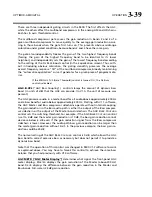
3-32
OPERATION ORBAN
MODEL
9400
The curves in the 9400’s equalizer were created by a so-called “minimax”
(“minimize the maximum error,” or “equal-ripple”) IIR digital approxi-
mation to the curves provided by the Orban 622B analog parametric
equalizer. Therefore, unlike less sophisticated digital equalizers that use
the “bilinear transformation” to generate EQ curves, the shapes of the
9400’s curves are not distorted at high frequencies.
Midrange Parametric Equalizer
is a parametric equalizer whose boost and cut
curves closely emulate those of an analog parametric equalizer with conventional
bell-shaped curves.
MID FREQ
determines the center frequency of the equalization, in Hertz.
Range is 250-6000Hz.
MID GAIN
determines the amount of peak boost or cut (in dB) over a
10 dB range.
MID WIDTH
determines the bandwidth of the equalization, in octaves.
The range is 0.8-4.0 octaves. If you are unfamiliar with using a parametric
equalizer, 1 octave is a good starting point.
The audible effect of the midrange equalizer is closely associated with the amount
of gain reduction in the midrange bands. With small amounts of gain reduction, it
boosts power in the presence region. This can increase the loudness of such material
substantially. As you increase the gain reduction in the midrange bands (by turning
the
M
ULTIBAND
D
RIVE
(Multiband Drive) control up), the
M
ID
G
AIN
control will have
progressively less audible effect. The compressor for the midrange bands will tend to
reduce the effect of the
M
ID
frequency boost (in an attempt to keep the gain con-
stant) to prevent excessive stridency in program material that already has a great
deal of presence power. Therefore, with large amounts of gain reduction, the den-
sity of presence region energy will be increased more than will the level of energy in
that region.
Use the mid frequency equalizer with caution. Excessive presence boost tends to be
audibly strident and fatiguing. Moreover, the sound quality, although loud, can be
very irritating. We suggest a maximum of 3 dB boost, although 10 dB is achievable.
In some of our factory music presets, we use 3 dB boost at 2.6 kHz to bring vocals
more up-front.
High Frequency Parametric Equalizer
is a parametric equalizer whose boost and
cut curves closely emulate those of an analog parametric equalizer with conven-
tional bell-shaped curves.
HIGH FREQ
determines the center frequency of the equalization, in
Hertz. The range is 1-15 kHz.
HIGH GAIN
determines the amount of peak boost or cut over a
10 dB
range.
HIGH WIDTH
determines the bandwidth of the equalization, in octaves.
The range is 0.8-4.0 octaves. If you are unfamiliar with using a parametric
equalizer, one octave is a good starting point.
Excessive high frequency boost can exaggerate hiss and distortion in program mate-
rial that is less than perfectly clean. We suggest no more than 4 dB boost as a practi-
Summary of Contents for Optimod-AM 9400
Page 1: ...Operating Manual OPTIMOD AM 9400 Digital Audio Processor Version 1 2 Software...
Page 7: ...Operating Manual OPTIMOD AM 9400 Digital Audio Processor Version 1 2 Software...
Page 52: ......
Page 204: ......
Page 232: ......
Page 260: ......
Page 261: ...OPTIMOD AM DIGITAL TECHNICAL DATA 6 29...
Page 267: ...OPTIMOD AM DIGITAL TECHNICAL DATA 6 35 CPU Module...
Page 273: ...OPTIMOD AM DIGITAL TECHNICAL DATA 6 41 RS232 BOARD PARTS LOCATOR...
Page 275: ...OPTIMOD AM DIGITAL TECHNICAL DATA 6 43 8300 POWER SUPPLY PARTS LOCATOR...
Page 284: ...6 52 TECHNICAL DATA ORBAN MODEL 9400 DSP BOARD PARTS LOCATOR DRAWING 32170 000 14...
Page 292: ...6 60 TECHNICAL DATA ORBAN MODEL 9400 DISPLAY BOARD PARTS LOCATOR...
Page 293: ...OPTIMOD AM DIGITAL TECHNICAL DATA 6 61 DISPLAY BOARD...
















































